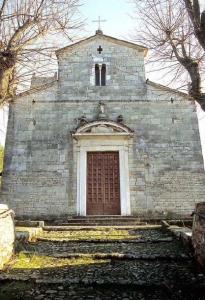
Information
Foundation:
IX century
District/Location:
Camaiore
District:
Versilia


This extremely old and powerful Parish Church, well preserved in its 12th century appearance, was forced to give up power to the previously dependent Church of S. Maria after this was re-founded in 1255 and became a point of reference for the whole area.
Chiesa San Giovanni Battista e San Stefano Camaiore, località La Pieve Piazza Don Renzo Gori 55041 Camaiore LU Italia
First recorded in 820, the Parish Church S. Stefano had limited access to its revenue, which had been conceded to a local aristocratic family, for the entire 10th century.
The "Estimo" of 1260 records this Parish Church as heading no less than 17 churches dotted around the nearby hills, but it was soon destined to rapidly lose this wealth and importance. The tumultuous events leading up to the mid-13th century, with Lucca attempting to expand in Versilia in opposition to the large feudal families that still owned property in the area, concluded in favour of Lucca that re-founded the town of Camaiore around 1255 and in 1374 provided it with walls and ramparts. The Rectory of S. Maria of Borgo Camaiore, cited in the "Estimo" of 1260, went on to become the area’s head church. In consequence, the income of the Parish Church dropped significantly in little time, in 1366 the right to name the rector of the Church of Saints Maria and Michele in Camaiore was contested and in 1387 it was forced to grant this church the right to perform christenings.
Today, this old Parish Church with its bell tower, largely preserves the form it assumed in the 12th century, incorporating parts of a previous 10th century building. It was renovated and enlarged in the 17th century including the addition of the portal, which partially obscures traces of a previous, notably asymmetric double opening. It has been suggested that this anomaly is due to an intentional correction in perspective to make the twin doors appear to be of the same height when approaching from the old, sharply sloping access road. A purist restoration in 1930 removed the majority of both the 17th and 19th century additions.
The interior, with a central nave and side aisles divided by pilasters, holds a christening font adapted from a sarcophagus from the 2nd-3rd century AD which bears putti figures holding the image of the deceased shaped like a round shield, and a 15th century triptych by Battista di Gerio, originally from the Church of Saints Giovanni and Reparata.
The "Estimo" of 1260 records this Parish Church as heading no less than 17 churches dotted around the nearby hills, but it was soon destined to rapidly lose this wealth and importance. The tumultuous events leading up to the mid-13th century, with Lucca attempting to expand in Versilia in opposition to the large feudal families that still owned property in the area, concluded in favour of Lucca that re-founded the town of Camaiore around 1255 and in 1374 provided it with walls and ramparts. The Rectory of S. Maria of Borgo Camaiore, cited in the "Estimo" of 1260, went on to become the area’s head church. In consequence, the income of the Parish Church dropped significantly in little time, in 1366 the right to name the rector of the Church of Saints Maria and Michele in Camaiore was contested and in 1387 it was forced to grant this church the right to perform christenings.
Today, this old Parish Church with its bell tower, largely preserves the form it assumed in the 12th century, incorporating parts of a previous 10th century building. It was renovated and enlarged in the 17th century including the addition of the portal, which partially obscures traces of a previous, notably asymmetric double opening. It has been suggested that this anomaly is due to an intentional correction in perspective to make the twin doors appear to be of the same height when approaching from the old, sharply sloping access road. A purist restoration in 1930 removed the majority of both the 17th and 19th century additions.
The interior, with a central nave and side aisles divided by pilasters, holds a christening font adapted from a sarcophagus from the 2nd-3rd century AD which bears putti figures holding the image of the deceased shaped like a round shield, and a 15th century triptych by Battista di Gerio, originally from the Church of Saints Giovanni and Reparata.
Scopri altre attrazioni vicino a Parish Church of Saints Giovanni Battista and Stefano
See allYou may also like..
See allFind more
0











